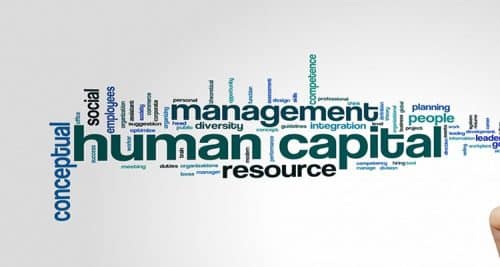The employee life cycle begins with the job search and concludes when an employee quits the company. Gallup identifies seven stages in total: recruit, hire, onboard, engage, perform, develop, and exit. Human capital management refers to how organizations address these stages. Let’s learn more about the human capital management system and software solutions in this post.
What is the Definition of Human Capital Management?
Human capital management is a practice used by businesses to attract, recruit, train, develop, and retain the best personnel in order to meet short- and long-term goals. The method enables businesses to invest in their personnel in order for them to contribute at the maximum level to the attainment of corporate objectives. Employees are viewed as precious resources that must be utilized in order to reach their full potential by HCM.
Organizations that rely on their workers to achieve the majority of their goals devote resources to growing and developing the key skills and competencies that their employees require to produce results. Human capital management assists them in identifying gaps in their competencies and focusing recruitment efforts on filling such gaps. Employees will be more satisfied with their jobs since they will be working in positions that allow them to utilize their abilities. Human capital management produces a devoted workforce that helps the firm achieve its goals.
What is involved in Human Capital Management?
Human capital management is concerned with adding value to an organization’s human resources so that they can achieve the best results possible. It addresses human resource functions, remuneration, performance, and other critical aspects critical to a company’s tactical and strategic vision and goal.
Human capital management is a procedure for improving a company’s employees’ performance and efficiency. It offers a comprehensive strategy for guiding talent acquisition, recruiting, onboarding, employee training and development, performance review, and feedback.
By recognizing each person’s abilities and competencies and matching them with a role that allows them to maximize their potential, this approach provides an environment that allows individual employees to succeed. This provides the organization with a high return on investment in employee training while also increasing employee work satisfaction.
Human capital management may help to build a strong organizational culture that encourages employee development, honest feedback, and dedication to the company’s goals. It can provide employees greater influence over their careers and motivate them to commit their skills and talents to the firm in the long run.
A Brief History of Human Capital Management
The term “human capital” first appeared in the 1950s and 1960s, as computing began to accelerate industrial-era automation. Economists and business people began to consider employees as knowledge workers with special abilities and talents that might propel business growth, rather than as replaceable units executing regular tasks.
Unsurprisingly, the word resurfaced with the emergence of the internet in the late 1990s. New technologies were rapidly automating a slew of new corporate procedures. While the internet altered the ways in which employers and managers worked and cooperated. All of this upheaval required workforce leaders to rethink how they approached attracting, keeping, and engaging individuals in an ever-changing set of job positions.
This decade could be referred to as the “Golden Age of HCM.” HR professionals can now provide a more engaging and tailored employee experience at scale thanks to new digital technology. Simultaneously, developing technologies such as data automation, predictive analytics, and artificial intelligence (AI) have introduced new approaches to understanding, managing, incentivizing, and engaging the workforce. And HR directors now have a plethora of innovative tools at their disposal to maximize the value of their employees, ranging from intelligent, social-driven recruiting and individualized retention techniques to highly optimized compensation.
Read Also: Human Capital: Definition, Theories & Roles in the Economy
What Are the Practices Involved in Human Capital Management?
Human capital management encompasses a wide range of administrative and strategic activities and processes, including the following:
- Planning
- Compensation preparation
- Recruiting and selection
- Onboarding
- Training
- Attendance and timing
- Payroll
- Management of performance
- Workflow management
- Analytics and reporting
- Compliance
- Self-service and employee service
- Administration of benefits
- Services for the elderly
The Advantages of Human Capital Management
The most significant advantage of human capital management is that it enables firms to maximize the value of their personnel. It simplifies human resource obligations and provides a number of other advantages. Here are some of the advantages of human capital management:
#1. Improve human capital management
The primary benefit of human capital management is that it gives a method for managing a company’s human resources. It establishes a comprehensive structure that the human resources department may use to deliver the best employees and train them to fulfill company goals.
#2. Improve the hiring procedure
Human capital management that is effective makes it easier to attract the top individuals to your firm. It provides hiring managers with a database of candidates who have the most relevant job-specific abilities and experiences. Interviewers and the company’s public relations team can use human capital management to portray the firm as an ideal employer, enticing candidates who can deliver outcomes. This approach also streamlines the onboarding process and makes it easier for new applicants to integrate into the firm.
#3. Determine capability gaps
Human capital management plays a critical role in identifying workforce capability gaps. This allows the human resources department to alter the recruitment criteria in order to fill positions that will increase the organization’s ability to fulfill its goals.
#4. Boost organic growth
Human capital management is a significant instrument for organic growth because it can discover individual employees’ competencies. It accomplishes this by assisting the organization in optimizing internal resources in order to increase production and revenue. This is achievable because human capital management focuses on employee growth and development, providing them with the skills necessary to generate excellent results.
#5. Align positions with employee skills.
Human capital management can assist firms in matching individuals with positions that allow them to put their skills and talents to use. This is due to the system’s processes for identifying employees’ specific strengths and competencies. Employees are better satisfied at work when they are placed in positions that allow them to use their skills, and the organization benefits from increased production, efficiency, and loyalty.
#6. Enhance productivity and efficiency.
Human capital management is all about maximizing returns by making the greatest use of existing human resources. Human capital management boosts productivity by investing in training that develops specialized talents required by the firm to achieve its goals. It also enhances efficiency since the human capital management system places employees in roles that allow them to perform to their full potential.
#7. Improve performance evaluations
Human capital management fosters excellence by increasing the efficacy of performance appraisals. It offers many degrees of employee appraisal, such as self-reviews, peer reviews, and manager reviews. Employees are motivated to do more as a result of receiving actionable feedback on their contributions to the organization.
#8. Facilitates better career planning
Employees have more control over their jobs thanks to human capital management. It detects competence gaps through training, surveys, performance assessments, and other input sources. This enables employees to identify areas in which they need to develop in order to achieve better results in terms of personal and corporate goals.
What Is the Difference Between Human Capital Management and Human Resource Management?
Although the names are frequently used interchangeably, they have distinct meanings. Human resource management (HRM) is largely concerned with core administrative HR responsibilities such as personnel record keeping and benefits administration. Human capital management is a wide word that encompasses both HRM and strategic tasks such as analytics and performance management.
HCM seeks to maximize the value and ROI of an organization’s workers. Human resource management is responsible for developing and managing the system and processes required to acquire, train, and retain the organization’s staff.
Functions of Human Capital Management
Human capital management’s major goal is to increase the value of people’s resources so that they can contribute meaningfully to the organization. The following are the roles of human capital management in a business:
#1. Recruit talent
Attracting and hiring talent to assist the firm to achieve its goals is one of the most critical functions of human capital management. It gives the human resources department all the tools it needs to promote the firm as an ideal environment for the best prospects and make the recruitment process go smoothly.
#2. Positioning
Human capital management necessitates the smooth and efficient onboarding of new personnel. It introduces them to the company culture, job needs, and expectations, as well as creating an enabling environment that assists them in fitting into their responsibilities.
#3. Employee education and development
Another purpose of human capital management is to give proper training to employees so that they can deliver the greatest results for the firm. It fosters a climate that stimulates growth and development in order to help employees acquire new skills and capacities that will enable them to generate better results and progress in their careers.
#4. Retention of employees
Human capital management seeks to promote employee job satisfaction by allowing them to apply their skills and knowledge to help the organization achieve its goals. This instills a sense of belonging in employees while also making them feel appreciated and loyal to their company.
#5. Efficient performance evaluation and feedback
Human capital management develops numerous performance measurement tools in order to increase productivity and efficiency. This approach, through a variety of employee reviews and surveys, can assist management in identifying gaps in training, resources, job satisfaction, and other factors that can affect workforce effectiveness. The company can then utilize this information to provide feedback to all stakeholders in order for them to improve and achieve greater results.
#6. Allows data access
Human capital management provides a repository of actionable knowledge that can assist management in adding more value to its personnel. Data from performance reviews, employee benefits claims, skills, turnover rate, and other critical statistics can assist the firm in adjusting its plans and practices to improve the work environment and achieve goals.
How Can Human Capital Management Be Improved?
Organizations that rely heavily on their people for a large portion of their success must always seek new ways to manage their human capital. Here are some suggestions for improving human capital management:
#1. Invest in current employees
Many businesses devote efforts to finding and employing fresh talent at the expense of existing personnel. This can impede the firm from realizing the full potential of its present workforce. Organizations can achieve more organic growth with lower training expenses by investing in the growth and development of present personnel. This can boost job satisfaction and employee retention rates.
#2. Make human capital management more personalized
To achieve greater success, take a more individualized approach to human capital management. Individuals differ, and each individual will digest knowledge and guidelines in a unique manner. Rather than applying the same solution to everyone, attempt to understand each person’s strengths and shortcomings and create an environment that encourages everyone to improve their abilities and knowledge.
#3. Make use of technology
Human capital management can benefit from technological solutions. Mobile apps can help with training, communication, and collaboration, as well as removing time and location obstacles. It can also help you automate various corporate operations, save operating expenses, and shorten the time it takes employees to access, share, and submit feedback.
#4. Align human capital management with business objectives
Matching human capital management with business objectives is a wonderful strategy to improve it. The organization can identify the competencies it requires to tackle specific business problems by integrating human capital management with its business strategy. To satisfy client expectations, the company may need to train its IT employees on the use of a new software application, for example.
#5. Enhance communication
Communication is a vital success component in human capital management. Improved communication can lead to increased employee engagement and a better understanding of human capital management operations. Employees will be able to understand the company’s expectations and what they will receive as a result of this.
Human Capital Management Software
Many of the roles and processes required for effective workforce management are handled by human capital management software, saving time and money. Human capital management software is sometimes known as a human resource information system (HRIS) or a human resource management system (HRMS).
Full-featured human capital management software automates and simplifies tasks like:
- Recruiting
- Tracking of applicants
- Onboarding
- Employee documentation
- Management of workflows and approvals
- Attendance and timekeeping
- Payroll
- Management of performance
- Self-service for employees
- Analytics and reporting
There are numerous human capital management software packages available on the market. Because their capabilities and advanced functions differ, it is critical to carefully examine your organization’s current and future demands before deciding on one.
Some firms purchase human capital management software that is placed on their own hard drive or server, but the majority prefer cloud-based human capital management software because it offers a variety of advantages such as access-from-anywhere convenience, flexible expansion capability, and automated software upgrades.
Key Advantages of a Robust Human Capital Management System
#1. Recruiting and Retaining Talent
- Improve hiring speed and quality by quickly sourcing and recruiting qualified individuals. Increase employee engagement by using work-life solutions that assist motivate employees and provide a better employee experience.
- Retain and develop talent through providing chances for professional learning and advancement.
- Increase bench strength by proactively planning for leadership and other critical roles succession.
#2. Optimized Workforce Management and Spending
- Differentiate compensation by allocating the appropriate mix of monetary and nonmonetary incentives.
- Manage time and labor, as well as scheduling and related costs.
- Expenses for specific projects and other costs should be kept separate.
- Create a culture of pay-for-performance.
#3. Respond to Change with Agility
- Align people and business strategies.
- With comprehensive analytics, you can predict employee attrition.
- Quickly adapt the workforce to organizational changes.
- HR practices should be tailored to meet the demands of each individual.
#4. Simplify HR Operations
- Consolidate disparate HRMS systems.
- Use analytics to make better informed personnel decisions.
- Automate manual operations on a global and local scale.
- Self-service can help to speed up HR operations.
HCM Solutions’ Functional Components
HR
Reduce the complexity of your HRIS systems and manage your whole workforce with a single, global system of record.
- Employee lifecycle management: Manage all personnel, full-time and contingent, from hire to retirement, including localizations for over 200 countries and jurisdictions.
- Strategic HR: With a single solution, track personal and employment information, establish job hierarchies, manage personnel documentation, and anticipate performance and attrition.
- HR service delivery: Provide management and employee self-service on any device, as well as an HR Help Desk for sensitive HR matters.
- Employee engagement: Use health, competitions, volunteering, and personal branding tools to motivate your employees.
- Compliance and fraud detection: Improve health and safety by reporting incidents, and protect your data by using fraud detection and autonomous security.
Talent Management
Allow organizations to manage the entire talent lifecycle, from sourcing and recruiting to onboarding new hires, managing goals, and performance, rewarding for performance, providing continuous learning, developing careers, conducting talent reviews, and planning for best-fit successors—all while keeping employees engaged.
- Talent acquisition: By employing innovative technology, present a compelling candidate-centric experience and match the best-fit individuals to vacancies.
- Performance management: entails aligning individual and organizational goals and providing staff with frequent checkpoints to maximize performance.
- Career development: entails identifying career prospects and maintaining a development plan to help employees achieve their career objectives.
- Talent assessment and succession planning: Assess macro-organizational talent trends and plan ahead of time for future demands in leadership and other essential jobs.
- Learning: Meet the modern workforce’s learning demands and maintain employees’ skills up to date. Make use of embedded intelligence to deliver a personalized learning experience.
Management of Employees
Control labor expenses, decrease manual processes and make compliance easier for all of your employees around the world.
- Compensation: includes the analysis, modeling, budgeting, and management of local and worldwide compensation schemes.
- Total compensation: In-depth knowledge of all remuneration activity directed at executives, managers, and employees.
- Pay-for-performance: Factor in performance ratings, target attainment, and other measures when calculating compensation.
Employee Benefits
Using a distinct workforce rewards plan, you can attract and retain the right employees while also driving value. Using cutting-edge technology, you can improve the accuracy of payroll and compensation data.
- Compensation: includes the analysis, modeling, budgeting, and management of local and worldwide compensation schemes.
- Benefits: Provide versatile benefit program options that can be tailored to specific corporate requirements.
- Payroll: Process payroll while also ensuring compliance by delivering correct payroll, tax reporting, and regulatory standards.
Internal HCM Reporting
Analyzing and reporting human capital data to top management and line managers will result in better-informed decisions about what actions or practices will improve business results, increased ability to recognize problems and take swift action to address them, and the ability to demonstrate the effectiveness of HR solutions and thus support the business case for increased investment in human capital. As a result, the act of internally reporting data and drawing conclusions from it is an essential component of HCM. It is critical to understand what data is required and how it will be delivered and used. The following criteria influence the selection of what should be reported in the form of metrics:
- The type of organization – measurements are context-dependent;
- Firm’s business goals;
- Organization’s business drivers, i.e. the elements that contribute to the attainment of company goals, such as revenue growth, cost control, customer service, quality, innovation, expansion through mergers and acquisitions, product development, and market development;
- Organization’s existing key performance indicators (KPIs);
- The usage of a balanced scorecard, which allows for a holistic view of performance by referencing four perspectives: financial, customer, innovation and learning, and internal processes;
- The accessibility of data;
- Use of data – only metrics that can be used to guide strategy and report on performance should be used.
- Data manageability – there may be a wide range of metrics available, and it is critical to be selective in light of the preceding analysis so that the burden of collecting, analyzing, and evaluating data is not too great and people do not suffer from information overload; remember that the cost of perfection is prohibitive, but the cost of reasonable approximation is less.
Cloud-based Human Capital Management
Cloud and software-as-a-service (SaaS) delivery options are rapidly becoming the new standard for human capital management technologies. The cloud method speeds up deployment, converts variable capital spending into fixed and transparent operational expenses, reduces IT costs and increases agility by speeding up and simplifying upgrade pathways.
There are several SaaS HCM suppliers, but they are not all the same. Businesses must ask crucial questions when assessing vendors and solutions, taking into account not only the HCM capabilities they require today but also those they will require in the future.
- Will the service provider remain around in the long run?
- Is the service provider investing on innovation?
- Will the provider be able to protect highly sensitive employee information?
- Is it possible for the supplier to maintain data in country-specific locations for regulatory reasons?
- Can you choose your own upgrade path and timetable?
- Will you be able to rapidly and efficiently connect HR operations with ERP, CRM, and other business processes?
What factors should be considered when selecting a Human Capital Management System?
Choosing the proper HCM partner for your organization can be a daunting undertaking at times, but it is doable with a focused, planned, and strategic procurement process.
- Create a requirements checklist that explains the business goals that are dependent on HCM and how failure to achieve them would affect your firm. This might assist you in determining which HCM solutions are most suited to your requirements.
- Make a plan of action that includes the project scope, required resources, budget, and team leaders.
- Determine the internal stakeholders who will be most impacted by the project and keep them updated at all times.
- Familiarize yourself with the approval process for transformative projects and outsourced solutions in your organization.
- Securing stakeholder acceptance is as simple as presenting the solution and emphasizing the business, financial, and end-user benefits. An HCM business case template can assist you in effectively making your point.
Human Capital Management in the Future
Clearly, technology is upending the way we do business. New technologies are altering corporate tactics, removing job responsibilities, and opening up new employment prospects. However, as old hierarchical structures change, so does the workforce, which is converting into flatter, more agile networks of teams, becoming more mobile, global, and diverse. HCM is also fast-changing. Expect to see faster adoption of both traditional technologies like SaaS and mobile, as well as cutting-edge technologies like machine learning and AI.
- Mobile boosts engagement and efficiency by providing consumer-grade, self-service mobile apps to HR, workers, and managers.
- Being able to collaborate with peers and mentors in the organization boosts productivity for everyone.
- Chatbots provide replies to constituents more quickly and efficiently.
- What is not humanly doable is augmented by AI, such as fast sifting hundreds of resumes and data points to locate best-fit candidates.
What is talent management in HCM?
Talent management is the process of attracting, retaining, and developing employees in order to meet the current and future needs of an organization.
What is talent development in HCM?
Talent development is the process of providing employees with the skills and knowledge they need to succeed and grow in their careers.
What is talent optimization in HCM?
Talent optimization is the process of aligning employee development and performance with the goals and objectives of the organization.
How does HCM impact business performance?
HCM has a significant impact on business performance by improving the quality of the workforce and maximizing the potential of employees.
What are the benefits of HCM?
The benefits of HCM include increased productivity, improved employee engagement, enhanced employee development, and reduced turnover.
What is the difference between HCM and HR management?
HCM encompasses all aspects of managing people in an organization, while HR management focuses specifically on administrative and compliance-related tasks.
How does HCM differ from Talent Management?
HCM is a broader term that encompasses all aspects of managing people in an organization, while Talent Management is a subset of HCM that focuses specifically on attracting, retaining, and developing talent.
What Every Growing Company Should Know
Human capital management (or HCM) is more than just human resources jargon. It is a critical collection of procedures and processes used by firms to manage the employee life cycle.
Human Capital Management FAQs
Does HCM include payroll?
Most HCM suites are now attempting to incorporate payroll and labor management into their capabilities, hence broadening their scope of control to include HRMS solutions.
What are different types of human capital?
Human capital is further classified as follows: (1) Knowledge Capital, (2) Social Capital, and (3) Emotional Capital.
Which is human capital?
Human capital is the information, skills, and health that people invest in and collect over the course of their lifetimes, allowing them to reach their full potential as contributing members of society.
- Human Resource Management Society: All You Need To Know!!!
- Leadership Team: Developing an Effective Workforce
- Human Resource Management: Definition and Guide For Small Businesses
- The Importance of Resources for the Success of Any Business
- Human Resources Management (HRM): Definition, Outsourcing, and Functions






